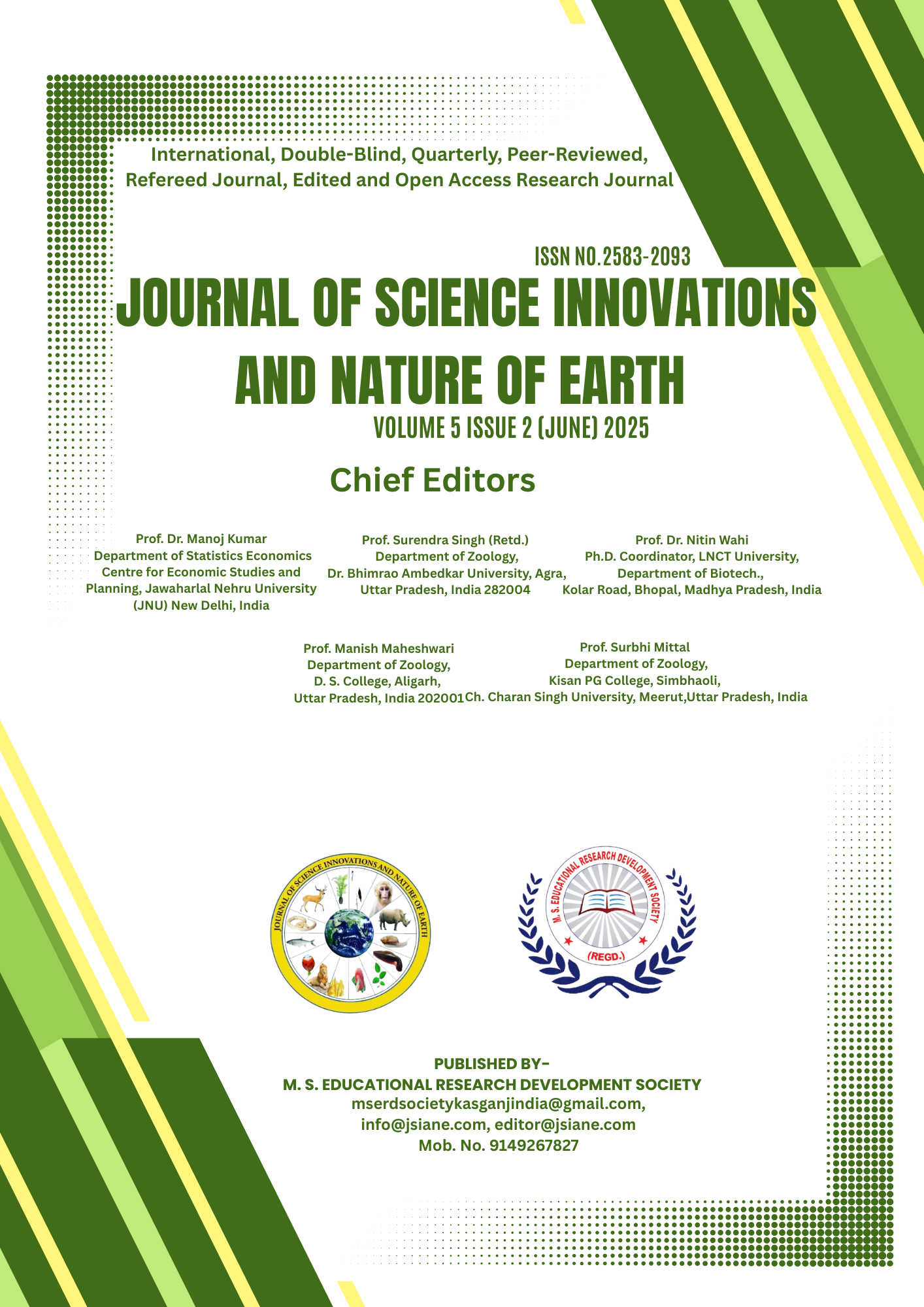Physicochemical Profiling of Urban Water Contaminants in Aligarh: Health Risk Assessment of Emerging Environmental Pollutants
DOI:
https://doi.org/10.59436/jsiane.378.2583-2093Keywords:
Urban water contamination, emerging pollutants, physicochemical profiling, heavy metals, risk assessmentAbstract
Urban water contamination constitutes one of the most significant threats to public health and environmental sustainability, especially in rapidly growing cities like Aligarh. The present study investigates the physicochemical characteristics of urban water contaminants with Aligarh at its focus, with special focus on emerging pollutants like pharmaceuticals, personal care products, heavy metals, and industrial effluents. For the research, water samples were taken from rivers and groundwater and supplemented by municipal supply sources. The analyses were carried out considering the concentration of the given pollutants. Standard analytical techniques used in the analysis included atomic absorption spectrometry, high-performance liquid chromatography, and mass spectrometry for quantification of the contaminants. It considers various sources of pollution, including domestic sewage, industrial discharge, and agricultural runoff, and identifies their influence on water quality. Based on the risk assessment arising from the levels of pollutants detected, the activity considered their toxicity, persistence, and bioaccumulative potential. The results are alarming, ranging from the high concentration levels of heavy metals like lead and mercury to the levels of pharmaceuticals and personal care products above the permissible limits. High risks to human health and the aquatic ecosystem posed by emerging pollutants in urban water systems urgently call for integrated water management strategies and more stringent regulations. It recommends future monitoring and policy development in protecting public health and making water resources sustainable in Aligarh.
References
Anjum, R., Ali, S. A., Siddiqui, M. A., Parvin, F., Khan, Z., Khan, N., ... & Nafees, M. (2023). Hydro-geochemical assessment of ground water for drinking and agricultural purposes and potential human health risk in Aligarh city, India. Chemical Engineering Journal Advances, 16, 100547.
Gani, A., Hussain, A., Pathak, S., Ahmed, S., & Omar, P. J. (2025). Impact of Pollutants on Groundwater Quality and Health Risk Assessment of Quaternary Aquifers in Northern India. Journal of Hazardous, Toxic, and Radioactive Waste, 29(1), 04024039.
Rahman, A. (2021). A GIS based DRASTIC model for assessing groundwater vulnerability in shallow aquifer in Aligarh, India. Applied geography, 28(1), 32-53.
Mohammad, N., Alam, M., & Beg, M. (2022). Technical Aspect of Water Resource Management of Aligarh District. In Sustainable Technology and Advanced Computing in Electrical Engineering: Proceedings of ICSTACE 2021 (pp. 569-580). Singapore: Springer Nature Singapore.
Arshad, I., & Umar, R. (2020). Status of urban hydrogeology research with emphasis on India. Hydrogeology Journal, 28(2), 477-490.
Chaudhary, S. and Kumar, A. (2012). Monitoring of Benzene, Toluene, Ethyl benzene and Xylene (BTEX) Concentration In ambient Air of Firozabad, India. International Archive of Applied Science & Technology, Vol. 3(2), 92-96.
Chaudhary, S. and Kumar, A. (2012). Study on Refuelling pump stations caused by BTEX Compounds in Firozabad city. International Archive of Applied Science & Technology, Vol. 3(2),75-79.
Chaudhary, S. and Sisodia, N. (2015). Analysis of Ketoconazole and Piribedil using Ion Selective Electrodes. IOSR Journal of Applied Chemistry, Vol. 8(1), Ver.II, 1-4.
Chaudhary, S. (2016). Effect of benzene and Xylene concentration on Public health in Ambient Air In City of Firozabad, India. PARIPEX – Indian Journal of Research,Vol. 5(11), 504-505.
Singh, V. and Chaudhary, S. (2019). Study of groundwater quality in Khurja city and adjoining areas of Khurja Borewell And hand-pump water. International Journal of Geography, Geology and Environment, 1(1), 95-9 9.
Chaudhary, S. and Singh, V. (2021). Toluene concentration at commercial site in ambient air of Firozabad and its Impact on human health, International journal of humanities, Law and Social Sciences, Vol. 8(1), 71-76.
Chaudhary, S. (2022). Benzene and Toluene concentration at different Traffic intersection during Pre-mid-post winter season, in ambient air of Aligarh and its impact on Human Health, PARIPEX - Indian Journal of Research, vol.11(8), 42-45.
Chaudhary, S. (2022). Effect of BTEX Concentrations on human health, in ambient air at different refuelling pump stations in Firozabad, Journal of Socio-Economic Review, Vol. 9(2), 34-41.
Chaudhary, S. (2023). Photo electrochemical (PEC) Study of The Dye Sensitized High Band Gap Structure of ZnO Semiconductor electrodes Prepared by the SOL-Gel Method, PARIPEX- Indian journal of Research, Vol. 12(9), 94-96.
Chaudhary, S. (2024). An Assessment of released Industrial Effluent and its impact on Water Quality, PARIPEX- Indian journal of Research, Vol. 13(8), 55-58.
Chaudhary, S. (2024). Role of Native plant Species in Phytoremediation of Heavy Metals from Contaminated Soil at Atrauli and Panethi, PARIPEX- Indian journal of Research, Vol. 13(8), 59-62.
Singh, Y., Chaudhary, S., Ravikant (2024). An Exhaustive examination of the models, methods, histories and viewpoints related to water quality Indexes (WQIs). AIRO journals, Vol. 3(1), 210-226.
Geeta, Chaudhary, S., Ravikant (2024). Heavy metals in Aligarg’s urban soil: An overview of health risks and pollution assessment, AIRO journals, Vol. 3(1), 228-244.
Chaudhary, S., Singh, V., Singh, S. K. (2024). A Study of New Approaches to Statistical Analysis of research data, J. Sci. Innov. Nat. Earth,Vol. 4(4), 24-29.
Chaudhary, S. (2024). Role of Nano Catalysts in Green Chemistry, J. Sci. Innov. Nat. Earth,Vol. 4(4), 08-11.
Geeta, Chaudhary, S. (2024). A Comprehensive Study on Native Plant Species for Phytoremediation of Heavy Metals Contaminated in Soil, J. Sci. Innov. Nat. Earth,Vol. 4(4), 15-19.
Singh, Y., Chaudhary, S. (2024). A Study of Innovative Approaches to Water Pollution Control: Emerging Strategies and Technologies, J. Sci. Innov. Nat. Earth,Vol. 4(4), 47-51.
Chaudhary, S. (2025). A Study of Toxic Heavy Metals In Released Treated/Untreated Waste water from Slaughterhouses of Khurja, Uttar Predesh. J. Sci. Innov. Nat. Earth, 5(1), ISSN:2583-2093, 5(1). 9-11.
Singh, Y., Chaudhary, S. (2025). Heavy Metal Concentration in Contaminated Water Caused by a Release of Industrial pollutants and City Waste. J. Sci. Innov. Nat. Earth, 5(1), ISSN:2583-2093, 5(1), 38-40.
Geeta, Chaudhary, S. (2025). Soil Quality Degradation Due to Heavy Metal Concentration in Contaminated Soil and its Remediation. J. Sci. Innov. Nat. Earth, 5(1), ISSN:2583-2093, 5(1), 43-45

Downloads
Published
Issue
Section
License
Copyright (c) 2025 Maharaj Singh Educational Research Development Society

This work is licensed under a Creative Commons Attribution-NonCommercial 4.0 International License.









